
Functions
2.11 Monitoring Functions
SIPROTEC, 7SJ62/64, Manual
C53000-G1140-C207-2, Release date 01.2008
203
2.11.1.6 Measurement Voltage Failure Detection
Requirements
The measurement voltage failure detection function, refered to as „Fuse Failure Monitor“ (FFM), only operates
under the following condition:
• Three phase-to-ground voltages are connected; with phase-to-phase voltages and V
N
or single-phase con-
nection, the function is disabled.
Purpose of the Fuse Failure Monitor
In case of a measuring voltage failure caused by a fault or a broken wire in the voltage transformer secondary
system, a zero voltage can be simulated to individual measuring loops. The displacement voltage element of
the sensitive ground fault detection, the directional overcurrent protection, the voltage-controlled inverse time
non-directional overcurrent protection, the undervoltage protection and the synchronization function in the
7SJ64 can thereby acquire incorrect measuring results.
Of course, supervision of the miniature circuit breaker and the Fuse Failure Monitor can be used at the same
time.
Mode of Operation - Grounded System
The device is informed of the application of the FFM in a grounded system via address
5301
FUSE FAIL MON.
Solid grounded
.
Note
On systems where the ground fault current is very small or absent (e.g. ungrounded supply transformers), fuse
failure monitoring must be disabled or set to
Coil.gnd./isol.
.
The logic diagram on the operating mode in a grounded system is illustrated in Figure 2-68. Depending on the
configuration and MLFB, the FFM operates with measured or calculated values V
N
or
I
N
. If zero sequence
voltage occurs without a ground fault current being registered simultaneously, then there is an asymmetrical
fault in the secondary circuit of the voltage transformer. The displacement voltage element of the sensitive
ground fault detection, the directional overcurrent protection (phase and ground function), the voltage-con-
trolled inverse time non-directional overcurrent protection, the undervoltage protection and the synchronization
function are blocked if parameter
5310
BLOCK PROT.
is set to
YES
.
The FFM picks up if the ground voltage V
N
is higher than the set limit value under address
5302
FUSE FAIL
3Vo
and if the ground current
I
N lies below the set limit value under address
5303
FUSE FAIL RESID
.
Pickup occurs in accordance with the configured values. A hysteresis of 105% for the dropout is integrated for
I
N
or 95% for V
N
. In case of low-current asymmetrical faults in systems with week infeed, the ground current
caused by the fault could lie below the pickup threshold of the Fuse Failure Monitor. Overfunctioning of the Fuse
Failure Monitor can, however, cause the feeder protection device to underfunction since all protection functions
that use voltage signals are blocked. In order to prevent overfunctioning of the FFM, the phase currents are
also checked. If at least one phase current lies above the pickup threshold of
5303
FUSE FAIL RESID
, it can
be assumed that the zero current created by a fault will equally exceed this threshold.
In order to immediately detect an existing fault after switching in, the following applies: If a ground current
I
N
is
detected within 10 seconds after recognition of the Fuse Failure criterion, the protection assumes a fault and
removes the blocking by the Fuse Failure Monitor for the duration of the fault. If, on the other hand, the voltage
failure criterion is present for longer than approx. 10 s, the blocking is permanently activated. After this time has
elapsed, it can be assumed that a fuse failure has actually occurred. Only 10 s after the voltage criterion has
been removed by correction of the secondary circuit failure, will the blocking automatically reset, thereby re-
leasing the blocked protection functions.
www
. ElectricalPartManuals
. com






























